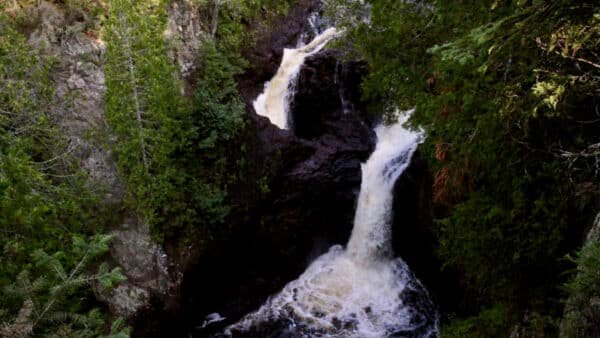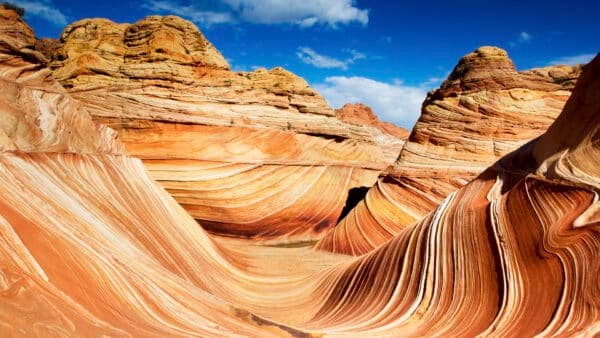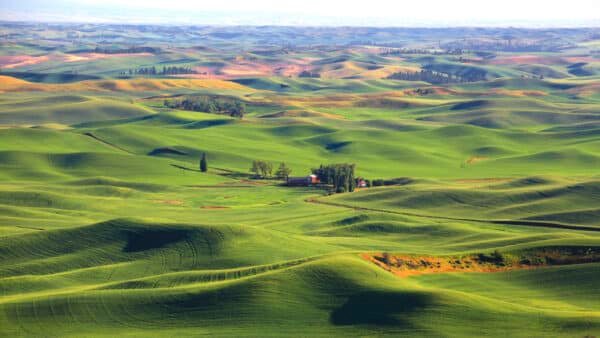As scrolling through Instagram you may have noticed something, it all looks the same… How many times can you post the same sunset from the same beach, or the same skyline from the same rooftop bar, before your followers start wondering if you’re stuck in some sort of scenic Groundhog Day? Meanwhile, everyone and their yoga instructor is posting from the Grand Canyon, Yellowstone, and those famous antelope slot canyons that now require advance reservations and a small mortgage to visit. Even flying to go to other places takes planning PTO, and money to get those famous shots of Santorini.
Here’s the thing about truly Instagram-worthy spots: the best ones are the places that make people stop mid-scroll and think, “Wait, where the hell is that?” These are the locations that spark genuine curiosity, inspire wanderlust, and let’s be real, make you look like you have insider knowledge about America’s hidden treasures.
We’re talking about places so photogenic they seem almost too perfect to be real, yet so unknown that you might be the first person in your social circle to discover them. These aren’t just pretty places, they’re conversation starters, bucket list additions, and the kind of spots that make people slide into your DMs asking for location details.
Hamilton Pool, Texas

About an hour west of Austin lies what might be the most photographically perfect swimming hole in America. This collapsed underground river creates a natural pool with a 50-foot waterfall cascading over a limestone overhang that looks like nature’s version of a luxury resort cabana. The emerald water, the perfect lighting filtered through the canopy above, and the sheer impossibility of the whole scene create photos that look almost too good to be real.
The best part? While everyone’s crowding into Austin’s Barton Springs, Hamilton Pool remains relatively unknown outside of Texas. Just remember to make a reservation – this natural wonder is protected, and access is limited to preserve its pristine beauty.
Thor’s Well, Oregon

Also known as the “Drain Hole of the Pacific,” Thor’s Well looks like someone punched a hole in the ocean floor and forgot to patch it up. Located along Oregon’s central coast near Yachats, this saltwater fountain creates some of the most dramatic and mysterious photos you’ll ever capture.
During high tide, waves crash into the hole and shoot up like a geyser, then appear to drain back into the earth. The effect is mesmerizing, especially during golden hour when the light turns everything into a fantasy landscape. It’s like something from Game of Thrones, but with better photo opportunities and no dragons trying to eat you.
Fly Geyser, Nevada

Created accidentally in 1964 during a geothermal test, Fly Geyser looks like something from another planet that crash-landed in the Nevada desert. The geyser continuously spouts water 5 feet into the air, while mineral deposits have created colorful terraces in brilliant reds, yellows, and greens. The whole formation is surrounded by desert that stretches to distant mountains, creating a surreal contrast that photographers dream about.
For decades, this wonder was on private land and nearly impossible to visit. Now it’s part of a nature preserve with limited public access, making it one of the most exclusive photo opportunities in America. The alien-like formations against the stark desert landscape create images that look like science fiction movie stills.
Antelope Island, Utah

While everyone’s posting from Arches and Zion, Antelope Island offers some of Utah’s most unique photo opportunities without the crowds. This island in the Great Salt Lake is home to free-roaming bison herds, and the surreal landscape of salt flats, distant mountains, and wildlife creates images that look like African safari photos – if African safaris happened on Mars.
The island’s beaches are unlike anything else in America, white sand created by salt deposits stretches to pink-tinged water, with massive bison casually photobombing your landscape shots. During sunset, the Great Salt Lake turns into a mirror that reflects the sky, creating double exposures that seem impossible without Photoshop.
Glass Beach, California

What started as a dumping ground for trash in the early 1900s has transformed into one of California’s most unique beaches. Decades of wave action have tumbled discarded glass into smooth, colorful pebbles that cover this Fort Bragg beach like nature’s own mosaic. The result is a shoreline that sparkles like scattered gems, especially when wet waves catch the light.
The beach creates photos that look like some kind of fantasy landscape, waves washing over multicolored glass “pebbles” while dramatic sea stacks rise from the Pacific. It’s like finding a treasure chest that the ocean has been polishing for decades. Just remember: look but don’t take, these glass treasures belong to the beach.
Devil’s Kettle Falls, Minnesota

This split waterfall in Judge C.R. Magney State Park presents one of geology’s most photographable mysteries. The Brule River splits around a rock formation – one side flows normally into the river below, while the other side disappears into a hole called the Devil’s Kettle, and no one knows where that water goes.
Scientists have tried everything from ping pong balls to dye to trace where the water ends up, but the mystery remains unsolved. The photos are as intriguing as they are beautiful – a perfectly normal waterfall next to what appears to be nature’s magic trick. It’s the kind of place that makes viewers stare at your photos trying to figure out what they’re seeing.
Sliding Rock, North Carolina

Hidden in the mountains near Asheville, Sliding Rock is a 60-foot natural water slide carved into smooth granite by Looking Glass Creek. The rock formation creates a perfect chute that dumps swimmers into a 8-foot-deep pool surrounded by lush forest. Photos capture both the thrill of people sliding down this natural slide and the pristine beauty of the mountain setting.
The images are pure joy, people laughing as they slide down smooth rock into crystal-clear mountain water, all surrounded by the kind of lush green forest that makes the Southeast’s mountains so photogenic. It’s like a scene from an adventure movie, except it’s a real place you can actually visit.
Havasu Falls, Arizona

Located within the Havasupai Tribal Lands in Arizona, these falls create some of the most stunning blue-green pools in America. The turquoise water – colored by high mineral content – cascades over red rock formations in a series of pools that look like something from a tropical resort, except you’re in the middle of the Arizona desert.
Getting here requires a challenging hike and advance reservations, which means the photos you’ll capture are genuinely exclusive. The contrast between the brilliant turquoise water and the red desert rock creates images so vivid they look heavily filtered, but it’s all completely natural. Fair warning: people will absolutely demand to know where this paradise is located.
Crater Lake’s Wizard Island, Oregon

While Crater Lake itself is famous, most people don’t venture beyond the rim viewpoints to capture the lake’s most photogenic feature: Wizard Island. This volcanic cinder cone rises from the impossibly blue water like something from a fantasy novel, creating photos that blend dramatic geology with mystical atmosphere.
The deep blue of the lake – some of the purest water in the world – provides a striking contrast to the dark volcanic rock of the island. Photos taken from different rim locations throughout the day capture how the light changes the character of this scene, from ethereal morning mist to dramatic afternoon shadows to golden hour magic.
The Wave, Arizona

This narrow canyon near the Arizona-Utah border features some of the most surreal rock formations in America. Wind and water have carved the sandstone into flowing, wave-like patterns that look like frozen ocean swells. The striped rock formations in shades of orange, yellow, and red create natural abstract art that seems almost too perfect to be real.
Access is extremely limited – only 20 people per day are allowed, and permits are awarded by lottery. This exclusivity means that photos from The Wave are genuinely rare and special. The flowing lines and vibrant colors create images that look like landscape photography crossed with abstract art.
Pfeiffer Beach, California

This Big Sur beach is famous among photographers for its purple sand (created by manganese garnet deposits) and the iconic Keyhole Rock formation that frames the sunset. During certain times of year, the sunset aligns perfectly with the natural arch, creating one of the most dramatic sunset photos possible on the California coast.
The purple-tinted sand creates unique foreground textures, while the rock arch provides a natural frame for sunset compositions. The combination of unusual sand color, dramatic rock formations, and perfect sunset alignment creates photos that look like they belong in a fantasy movie rather than on a California beach.
Carlsbad Caverns’ Big Room, New Mexico

While the caverns are known, most visitors stick to the elevator tour and miss the most photographable formations in the massive Big Room. This underground chamber is so large it could hold 14 football fields, with limestone formations that create natural sculptures illuminated by carefully placed lighting.
The scale of the caverns creates photos that challenge perception – tiny human figures dwarfed by massive stalactites and stalagmites that look like frozen waterfalls or ancient cathedrals. The lighting creates dramatic shadows and highlights that make the limestone formations look like carved marble sculptures.
Palouse Hills, Washington

The Palouse region of eastern Washington creates some of the most unexpected landscape photography in America. These rolling hills, covered in wheat fields and lentil crops, create patterns and textures that look more like abstract art than farmland. The undulating landscape changes color dramatically with the seasons and looks especially stunning from elevated viewpoints.
During spring and early summer, the green hills create compositions that look like a giant’s golf course or computer-generated landscape. The geometric patterns created by farming and the soft, rolling topography combine to create images that are both pastoral and surprisingly modern.
Maroon Bells Reflection, Colorado

While the Maroon Bells are famous, the perfect reflection photos happen at specific times and conditions that most visitors miss. Early morning visits during calm weather create mirror-perfect reflections in Maroon Lake that double the visual impact of these iconic peaks.
The key is timing – arriving before sunrise when the air is still and the lake surface is like glass. The resulting photos show the jagged peaks perfectly mirrored in the still water, creating compositions that look almost too symmetrical to be natural. Add fall aspen colors, and you have some of the most perfect mountain reflection photos possible.
White Sands Moonrise, New Mexico

While White Sands National Park is becoming more popular, most visitors miss the most dramatic photo opportunities that happen during specific lunar phases. Full moon rises over the white gypsum dunes create surreal nighttime landscapes that look like alien planets.
The pure white sand dunes provide perfect contrast for silhouetted figures or objects, while the moonlight turns the entire landscape into a glowing dreamscape. Long exposure photos capture both the moon’s path across the sky and the ethereal quality of the illuminated sand, creating images that challenge viewers’ understanding of what a desert should look like.
The Future of Hidden America

As social media continues to shape how we discover and share beautiful places, the value of unknown destinations will only increase. These spots offer something that famous locations can’t: the feeling of discovery and the satisfaction of finding beauty that isn’t already commodified and overcrowded.
Your followers are craving authenticity and novelty in their feeds. These hidden gems provide both, along with the inspiration to explore beyond the obvious destinations and discover the incredible diversity of landscapes that America has to offer.
